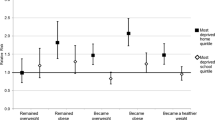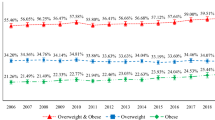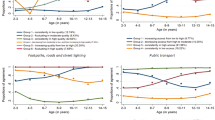Abstract
Objective:
It has been suggested that childhood obesity is inversely associated with deprivation, such that the prevalence is higher in more deprived groups. However, comparatively few studies actually use an area-level measure of deprivation, limiting the scope to assess trends in the association with obesity for this indicator. Furthermore, most assume a linear relationship. Therefore, the aim of this study was to investigate associations between area-level deprivation and three measures of adiposity in children: body mass index (BMI), waist circumference (WC) and waist-to-height ratio (WHtR).
Design:
This is a cross-sectional study in which data were collected on three occasions a year apart (2005–2007).
Subjects:
Data were available for 13 333 children, typically aged 11–12 years, from 37 schools and 542 lower super-output areas (LSOAs).
Measures:
Stature, mass and WC. Obesity was defined as a BMI and WC exceeding the 95th centile according to British reference data. WHtR exceeding 0.5 defined obesity. The Index of Multiple Deprivation affecting children (IDACI) was used to determine area-level deprivation.
Results:
Considerable differences in the prevalence of obesity exist between the three different measures. However, for all measures of adiposity the highest probability of being classified as obese is in the middle of the IDACI range. This relationship is more marked in girls, such that the probability of being obese for girls living in areas at the two extremes of deprivation is around half that at the peak, occurring in the middle.
Conclusion:
These data confirm the high prevalence of obesity in children and suggest that the relationship between obesity and residential area-level deprivation is not linear. This is contrary to the ‘deprivation theory’ and questions the current understanding and interpretation of the relationship between obesity and deprivation in children. These results could help make informed decisions at the local level.
This is a preview of subscription content, access via your institution
Access options
Subscribe to this journal
Receive 12 print issues and online access
$259.00 per year
only $21.58 per issue
Buy this article
- Purchase on Springer Link
- Instant access to full article PDF
Prices may be subject to local taxes which are calculated during checkout

Similar content being viewed by others
References
Foresight. Tackling Obesities: Future Choices In: Government Office for Science. Stationery Office: London; 2007.
Reilly JJ, Dorosty AR . Epidemic of obesity in UK children. Lancet 1999; 354: 1874–1875.
Lobstein TJ, James WP, Cole TJ . Increasing levels of excess weight among children in England. Int J Obes 2003; 27: 1136–1138.
Bundred P, Kitchiner D, Buchan I . Prevalence of overweight and obese children between 1989 and 1998: population based series of cross sectional studies. Br Med J 2001; 322: 326–328.
Chinn S, Rona RJ . Prevalence and trends in overweight and obesity in three cross sectional studies of British Children, 1974–94. Br Med J 2001; 322: 24–26.
Lobstein T, Baur L, Uauy R . Obesity in children and young people: a crisis in public health. Obes Rev 2004; 5 (Suppl 1): 4–104.
Jackson-Leach R, Lobstein T . Estimated burden of paediatric obesity and co-morbidities in Europe. Part 1. The increase in the prevalence of child obesity in Europe is itself increasing. Int J Pediatr Obes 2006; 1: 26–32.
Brown M, Byatt T, Marcsh T, McPherson K . Obesity Trends For Children Aged 2-11. Analysis From The Health Survey For England 1993–2007. National Heart Forum, Government Office for Science, 2009.
The NHS information centre. National Child Measurement Programme: England, 2010/11 school year. Stationery Office: London 2011.
Shrewsbury V, Wardle J . Socioeconomic status and adiposity in childhood: a systematic review of cross-sectional studies 1990–2005. Obesity 2008; 16: 275–284.
Stamatakis E, Primatesta P, Chinn S, Rona R, Falascheti E . Overweight and obesity trends from 1974 to 2003 in English children: what is the role of socioeconomic factors? Arch Dis Childhood 2005; 90: 999–1004.
Stamatakis E, Wardle J, Cole TJ . Childhood obesity and overweight prevalence trends in England: evidence for growing socioeconomic disparities. Int J Obes 2010; 34: 41–47.
Jebb SA, Rennie KL, Cole TJ . Prevalence of overweight and obesity among young people in Great Britain. Public Health Nutr 2004; 7: 461–465.
Cecil JE, Watt P, Murrie IS, Wrieden W, Wallis DJ, Hetherington MM et al. Childhood obesity and socioeconomic status: a novel role for height growth limitation. Int J Obes 2005; 29: 1199–1203.
O'Dea JA . Differences in overweight and obesity among Australian schoolchildren of low and middle/high socioeconomic status. Med J Aust 2003; 179: 63.
Townsend N, Rutter H, Foster C . Age differences in the association of childhood obesity with area-level and school-level deprivation: cross-classified multilevel analysis of cross-sectional data. Int J Obes 2012; 36: 45–52.
Dinsdale H, Ridler C, Rutter H, Mathrani S . National Child Measurement Programme Changes in children’s body mass index between 2006/07 and 2008/09. National Obesity Observatory: Oxford, 2010.
Singh GK, Siahpush M, Kogan MD . Rising social inequalities in US childhood obesity, 2003-2007. Annu Epidemiol 2010; 20: 40–52.
Sundblom E, Petzold M, Rasmussen F, Callmer E, Lissner L . Childhood overweight and obesity prevalences levelling off in Stockholm but socioeconomic differences persist. Int J Obes 2008; 32: 1525–1530.
Marmot M, Allen J, Goldblatt P, Boyce T, McNeish D, Grady M, Geddes L . Fair Society, Healthy Lives: Strategic Review of Health and Inequalities in England post-2010. The Marmot Review. University College London: London, UK 2010.
Stafford M, Brunner EJ, Head J, Ross NA . Deprivation and the development of obesity a multilevel, longitudinal study in England. Am J Prevent Med 2010; 39: 130–139.
Wardle J, Brodersen NH, Cole TJ, Jarvis MJ, Boniface DR . Development of adiposity in adolescence: five year longitudinal study of an ethnically and socioeconomically diverse sample of young people in Britain. Br Med J 2006; 332: 1130–1135.
Edwards KL, Cade JE, Ransley JK, Clarke GP . A cross-sectional study examining the pattern of childhood obesity in Leeds: affluence is not protective. Arch Dis Childhood 2010; 95: 94–99.
Dummer TJ, Gibbon MA, Hackett AF, Stratton G, Taylor SR . Is overweight and obesity in 9-10-year-old children in Liverpool related to deprivation and/or electoral ward when based on school attended? Public Health Nutr 2005; 8: 636–641.
Wake M, Hardy P, Canterford L, Sawyer M, Carlin JB . Overweight, obesity and girth of Australian preschoolers: prevalence and socio-economic correlates. Int J Obes 2007; 31: 1044–1051.
Booth ML, Macaskill P, Lazarus R, Baur LA . Sociodemographic distribution of measures of body fatness among children and adolescents in New South Wales, Australia. Int J Obes Rel Metab Disord 1999; 23: 456–462.
Reilly JJ, Wilson ML, Summerbell CD, Wilson DC . Obesity: diagnosis, prevention, and treatment; evidence based answers to common questions. Arch Dis Childhood 2002; 86: 392–394.
Rodriguez-Rodriguez E, Palmeros-Exsome C, Lopez-Sobaler AM, Ortega RM . Preliminary data on the association between waist circumference and insulin resistance in children without a previous diagnosis. Eur J Pediatr 2011; 170: 35–43.
Freedman DS, Serdula MK, Srinivasan SR, Berenson GS . Relation of circumferences and skinfold thicknesses to lipid and insulin concentrations in children and adolescents: the Bogalusa Heart Study. Am J Clin Nutr 1999; 69: 308–317.
McCarthy HD, Ellis SM, Cole TJ . Central overweight and obesity in British youth aged 11-16 years: cross sectional surveys of waist circumference. Br Med J 2003; 326: 624.
Griffiths C, Gately P, Marchant PR, Cooke CB . Cross-sectional comparisons of BMI and waist circumference in British Children: mixed public health messages. Obesity 2012; 20: 1258–1260.
Ulijaszek SJ, Kerr DA . Anthropometric measurement error and the assessment of nutritional status. Br J Nutr 1999; 82: 165–177.
McCarthy HD, Jarrett KV, Emmett PM, Rogers I . Trends in waist circumferences in young British children: a comparative study. Int J Obes 2005; 29: 157–162.
Cole TJ, Freeman JV, Preece MA . Body mass index reference curves for the UK, 1990. Arch Dis Childhood 1995; 73: 25–29.
McCarthy HD, Jarrett KV, Crawley HF . The development of waist circumference percentiles in British children aged 5.0–16.9 y. Eur J Clin Nutr 2001; 55: 902–907.
McCarthy HD, Ashwell M . A study of central fatness using waist-to-height ratios in UK children and adolescents over two decades supports the simple message—‘keep your waist circumference to less than half your height’. Int J Obes 2006; 30: 988–992.
Freedman DS, Kahn HS, Mei Z, Grummer-Strawn LM, Dietz WH, Srinivasan SR et al. Relation of body mass index and waist-to-height ratio to cardiovascular disease risk factors in children and adolescents: the Bogalusa Heart Study. Am J Clin Nutr 2007; 86: 33–40.
Department for Communities and Local Government. The English Indices of Deprivation 2007. Department for Communities and Local Government: London CaLG, editor 2008.
Department of Health. Healthy Lives, Healthy People: A call to action obesity in England, HM Government: London, UK 2011.
Department of Health. An update on the Government's approach to tackling obesity. National Audit Office: London, UK 2012.
Bronfenbrenner U . The Ecology of Human Development. Harvard University Press: Cambridge: MA, 1979.
Swinburn B, Egger G, Raza F . Dissecting obesogenic environments: the development and application of a framework for identifying and prioritizing environmental interventions for obesity. Prev Med 1999; 29 (6 Pt 1): 563–570.
Li F, Harmer PA, Cardinal BJ, Bosworth M, Acock A, Johnson-Shelton D et al. Built environment, adiposity, and physical activity in adults aged 50-75. Am J Prevent Med 2008; 35: 38–46.
Mehta NK, Chang VW . Weight status and restaurant availability a multilevel analysis. Am J Prevent Med 2008; 34: 127–133.
Mujahid MS, Diez Roux AV, Shen M, Gowda D, Sanchez B, Shea S et al. Relation between neighborhood environments and obesity in the Multi-Ethnic Study of Atherosclerosis. Am J Epidemiol 2008; 167: 1349–1357.
Li F, Harmer P, Cardinal BJ, Bosworth M, Johnson-Shelton D . Obesity and the built environment: does the density of neighborhood fast-food outlets matter? Amer J Health Promotion 2009; 23: 203–209.
Li F, Harmer P, Cardinal BJ, Bosworth M, Johnson-Shelton D, Moore JM et al. Built environment and 1-year change in weight and waist circumference in middle-aged and older adults: Portland Neighborhood Environment and Health Study. Am J Epidemiol 2009; 169: 401–408.
Frank LD, Andresen MA, Schmid TL . Obesity relationships with community design, physical activity, and time spent in cars. Am J Prevent Med 2004; 27: 87–96.
Cochrane T, Davey RC, Gidlow C, Smith GR, Fairburn J, Armitage CJ et al. Small area and individual level predictors of physical activity in urban communities: a multi-level study in Stoke on Trent, England. Int J Environ Res Public Health 2009; 6: 654–677.
Hoehner CM, Brennan Ramirez LK, Elliott MB, Handy SL, Brownson RC . Perceived and objective environmental measures and physical activity among urban adults. Am J Prevent Med 2005; 28 (2 Suppl 2): 105–116.
Janssen I, Boyce WF, Simpson K, Pickett W . Influence of individual- and area-level measures of socioeconomic status on obesity, unhealthy eating, and physical inactivity in Canadian adolescents. Am J Clin Nutr 2006; 83: 139–145.
Lee JM, Pilli S, Gebremariam A, Keirns CC, Davis MM, Vijan S et al. Getting heavier, younger: trajectories of obesity over the life course. Int J Obes 2010; 34: 614–623.
Sobal J . Obesity and socioeconomic status: a framework for examining relationships between physical and social variables. Med Anthropol 1991; 13: 231–247.
O’Dea JA, Dibley MJ . Obesity increase among low SES Australian schoolchildren between 2000 and 2006: time for preventive interventions to target children from low income schools? Int J Public Health 2009; 55: 185–192.
Acknowledgements
We thank Leeds City Council and More Life (formerly Carnegie Weight Management) for their initial collaboration in establishing the programme. In addition, we thank Leeds City Council and the secondary schools that participated in the programme for providing the data from the RADS.
Disclaimer
All authors had full access to all of the data and can take responsibility for the integrity of the data and the accuracy of the data analysis.
Author information
Authors and Affiliations
Corresponding author
Ethics declarations
Competing interests
The authors declare no conflict of interest.
Rights and permissions
About this article
Cite this article
Griffiths, C., Gately, P., Marchant, P. et al. Area-level deprivation and adiposity in children: is the relationship linear?. Int J Obes 37, 486–492 (2013). https://doi.org/10.1038/ijo.2013.2
Received:
Revised:
Accepted:
Published:
Issue Date:
DOI: https://doi.org/10.1038/ijo.2013.2
Keywords
This article is cited by
-
Length of paediatric inpatient stay, socio-economic status and hospital configuration: a retrospective cohort study
BMC Health Services Research (2017)
-
A cross sectional study investigating the association between exposure to food outlets and childhood obesity in Leeds, UK
International Journal of Behavioral Nutrition and Physical Activity (2014)
-
Reply to ‘Area-level deprivation and adiposity in children: is the relationship linear?’
International Journal of Obesity (2014)
-
Response to ‘Area-level deprivation and adiposity in children: is the relationship linear?’
International Journal of Obesity (2014)
-
Deprivation indices and childhood BMI: a re-evaluation
International Journal of Obesity (2013)



